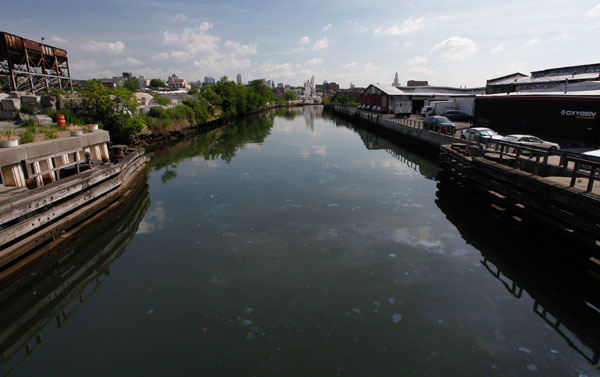
Photo by: Marc Fader
The Canal was created in the 1860s to bring raw material to rapidly developing residential Brooklyn.
For nearly six decades, Vivian Scarpati has lived within blocks of the Gowanus Canal in Brooklyn. In the 1970s, she married a man who lived on her street. Her husband’s family had lived a block east of the Canal—for four generations.
The Gowanus had long been a heavily polluted industrial area. The Canal was created in the 1860s to bring raw material to rapidly developing residential Brooklyn. Within years, toxic waste was in the water and on its banks. As early as the 1880s, local residents protested the contamination, sewage overflows and foul odors. A massive 1976 fire at the Patchogue Oil Terminal destroyed underground fuel tanks and resulted in more than 2.5 million gallons of oil spilling into the Canal—at the time, one of the largest oil spills in the nation’s history.
In 1981, Scarpati’s husband, James, passed away from lung and bone cancer at 33, leaving her with two kids to raise. Perhaps only a coincidence, her husband’s grandfather also died young of cancer. “There were other people in the neighborhood who died around the same age, so we always wondered,” Scarpati said.
No one can say for sure that the polluted canal contributed to Scarpati’s illness. But for residents who live near the Gowanus Canal, concerns about toxic hazards are certainly legitimate—so serious that the EPA recently overrode Bloomberg administration objections and finally declared the 1.8-mile waterway a Superfund site in March.
The EPA’s announcement clears the way for a multi-stage cleanup process to begin. Federal officials hope to complete a “remedial investigation” and an “ecological and risk assessment” by the end of the year.
Yet a careful examination by the NYCity News Service of thousands of pages of documents has illustrated just how entrenched the pollution actually is, and revealed the tangled mix of corporate interests that might share some liability for the project’s costs.
At least three distinct areas have been polluted. First is the water itself. The quality of the water has been tainted over time, due to accidental and intentional toxic spills. Complicating matters, the canal receives sewage overflow and street run-off that cascades from surrounding neighborhoods when it rains heavily.
Second, pollution is present in the canal banks and the land farther from the water, known as the “upland” areas. Over generations, the pollution—from direct spills or waste disposal—has flowed onto the land nearer Carroll Gardens and Park Slope, both of which are residential neighborhoods. Also, because of the soil composition, some of the contaminants have seeped from the water into the land—sort of a two-way toxic street.
Third, layers of sediment in the canal bed contain coal tar sludge, heavy metals, PCBs, pesticides, and volatile organic compounds, all of which can be carcinogenic.
The Superfund process, reserved for the nation’s most contaminated toxic waste sites, forces polluters to pay for cleanups, through lawsuits if necessary. If polluters cannot be found, then the EPA is able to use some of its own funds. The EPA estimates the total cost of the Gowanus Canal cleanup will be $300-500 million, but some say it could cost as much as $1 billion.
Hundreds of companies and government entities have polluted the Gowanus Canal since it began hosting ships with industrial cargo in the 1860s. Some continue to pollute today.
The most notorious actors were three manufactured gas plants (MGPs), which spewed coal tar and chemicals into the water and onto the banks of the canal. These plants produced fuel oil for gas street lamps and heaters during the 19th and 20th centuries.
Near the turn of the 20th century, the MGPs were acquired by Brooklyn Union Gas, which operated them into the 1960s. Eventually, through various mergers and acquisitions, National Grid, a multinational electricity and natural gas corporation, became the owner of the three sites.
In its announcement designating the canal a Superfund site, the EPA named National Grid and other companies it may hold responsible for contamination (potentially responsible parties or PRPs), with more to be identified in the coming months. Walter Mugdan, the Superfund director for the region, said that an agreement has already been reached with National Grid (which is also working with the state Department of Environmental Conservation through its brownfield program to clean up the contaminated land).
Other companies named by the EPA illustrate the complexities confronting the government as it seeks to establish liability.
ConEd, the major gas and electric utility, reportedly spilled oil and gasoline from some of its 14 underground storage tanks located just two blocks east of the canal. A U.S. Army Corp of Engineers report found there were at least six reported spills before the tanks were removed in 2003 and 2004. Besides the reported incidents, regulators have found volatile organic compounds and lead in the soil and groundwater near the old tanks, at levels that exceeded state standards.
The EPA requested documents and information about two of ConEd’s facilities – the refueling and truck yard near 3rd Avenue and its Gowanus substation located at the intersection of 27th Street and 3rd Avenue. ConEd lawyers replied with a detailed, firmly worded response that accompanied the documents.
“Con Edison expressly denies any liability for contamination at the Gowanus Canal Site, or for any investigation, response or remediation costs for the Gowanus Canal Site,” they wrote.
Another company whose Gowanus history is being scrutinized by the EPA is the Chemtura Corporation, a worldwide corporation that makes specialty chemicals and synthetic materials. A slew of toxic chemicals have been detected in the soil surrounding the company’s former plant near the mouth of the canal.
Chemtura acquired the property in 2005 when the previous owner, Crompton Corporation, was merged into the larger organization. That plant produced chemicals for carpet backing and rubber components under yet another previous owner – the Witco Corporation.
Witco’s Gowanus plant closed in 1999, and groundwater and soil samples in 2000 showed elevated concentrations of benzene, acetone, lead and cadmium and other chemicals, according to an Army Corps of Engineers report. A phone message left with Chemtura seeking comment was not returned.
In recent months, the EPA sent more than 20 letters notifying other companies that they may be on the hook to pay for the cleanup. These companies include: Amerada Hess Corporation, Bayside Fuel Oil Depot Corp., Rapid American Corp., Cibro Petroleum Products, Inc., Beazer East, Brink’s, Chevron, ConocoPhillips, BP and ExxonMobil. Even the U.S. Navy received a letter due to some WWII activity at the canal. And more recently, Kraft Foods and Citigroup received letters.
The city, which ran multiple facilities along the banks of the Canal, including a Department of Sanitation Incinerator on Hamilton Avenue, was another recipient.
Mayor Bloomberg opposed the Superfund process and the city presented its own alternative clean-up proposal. His administration said a listing would lower property values and delay or even kill ambitious development plans for the area, which sits in a valley between the desirable neighborhoods of Park Slope and Carroll Gardens.
At least two major projects in the area have been cancelled or suspended since the EPA announcement, but it is unclear what role the weak economy, as opposed to the Superfund designation, played in those decisions.
EPA Regional Administrator Judith Enck disputed some of the city’s claims and said the Superfund process was superior to the city’s alternative. “We have determined that it is the most efficient and comprehensive cleanup,” Enck said. Enck has estimated that the cleanup will take 10 to 12 years.
Despite the long process that awaits them, some local residents can hardly contain their excitement when envisioning a clean canal.
“If we were able to clean it up and restore the ecosystem—wow, what a great resource it could be for the community,” said Ludger Balan, an area resident and program director of the Urban Divers Estuary Conservancy, an environmental group. “Engaging people in coming out to the water—it could be a place you could bring your kids.”








